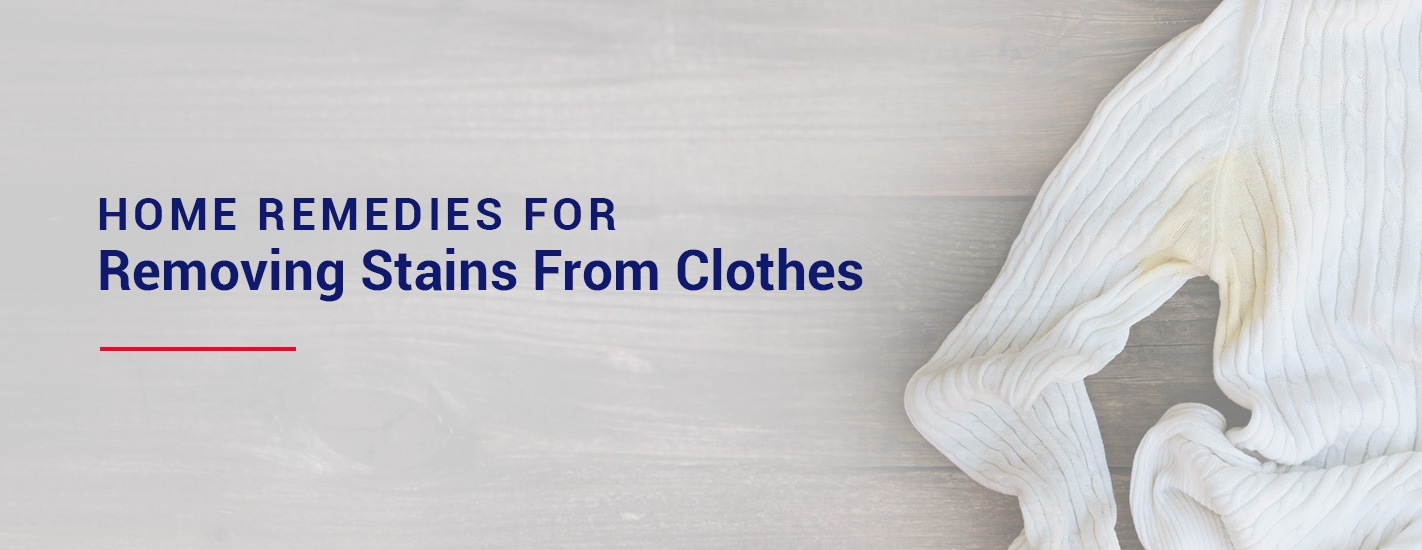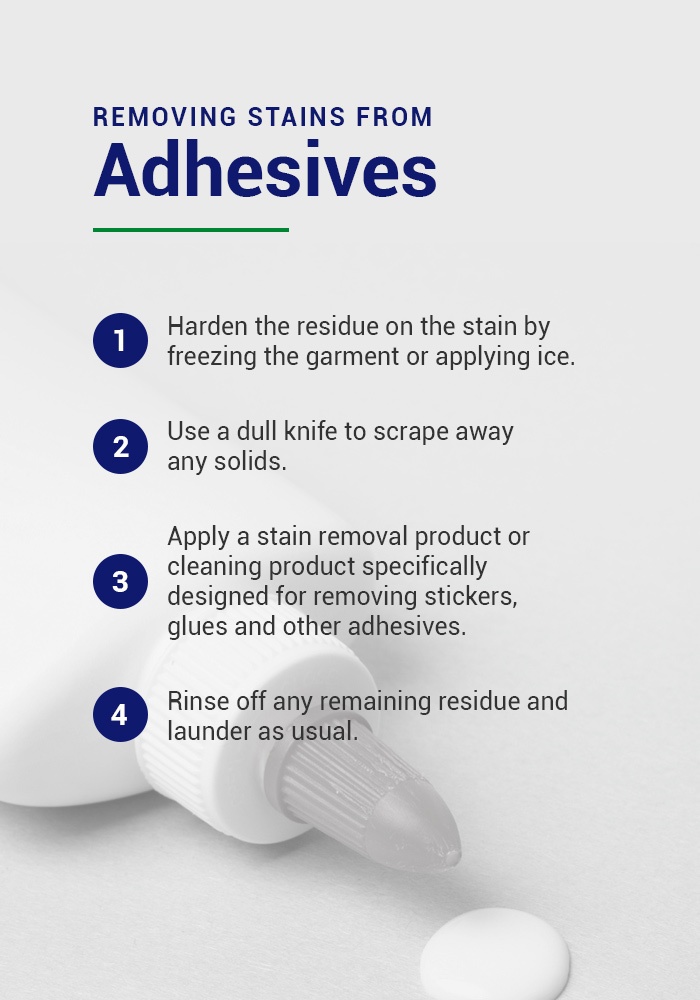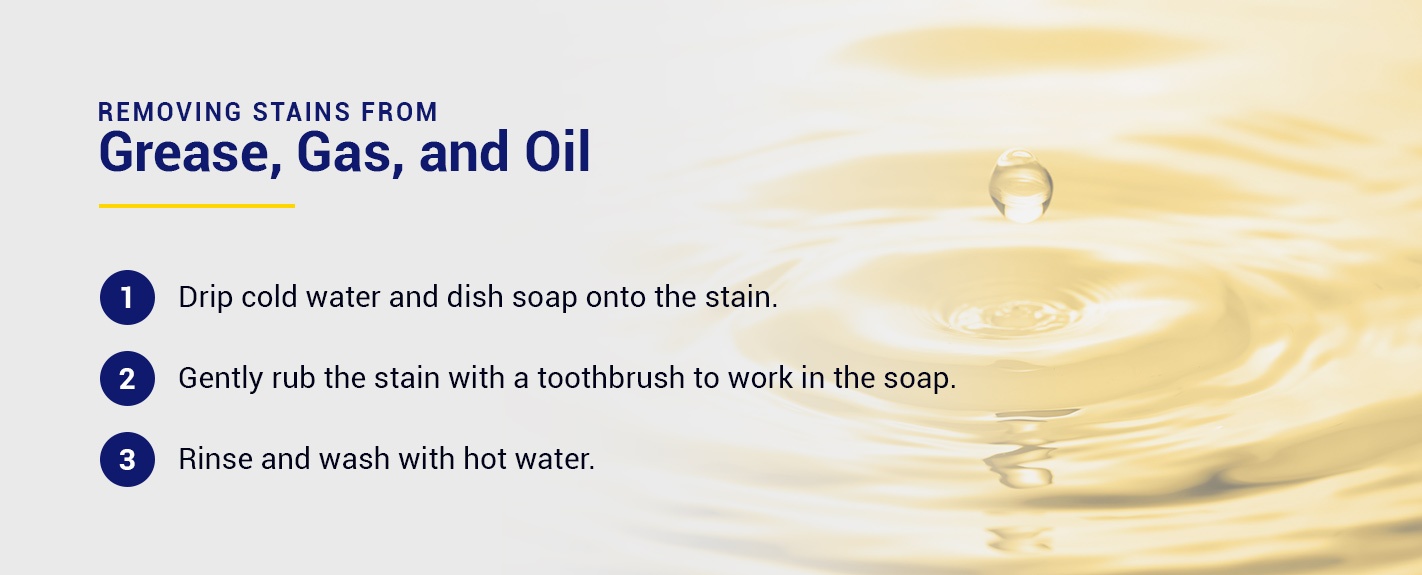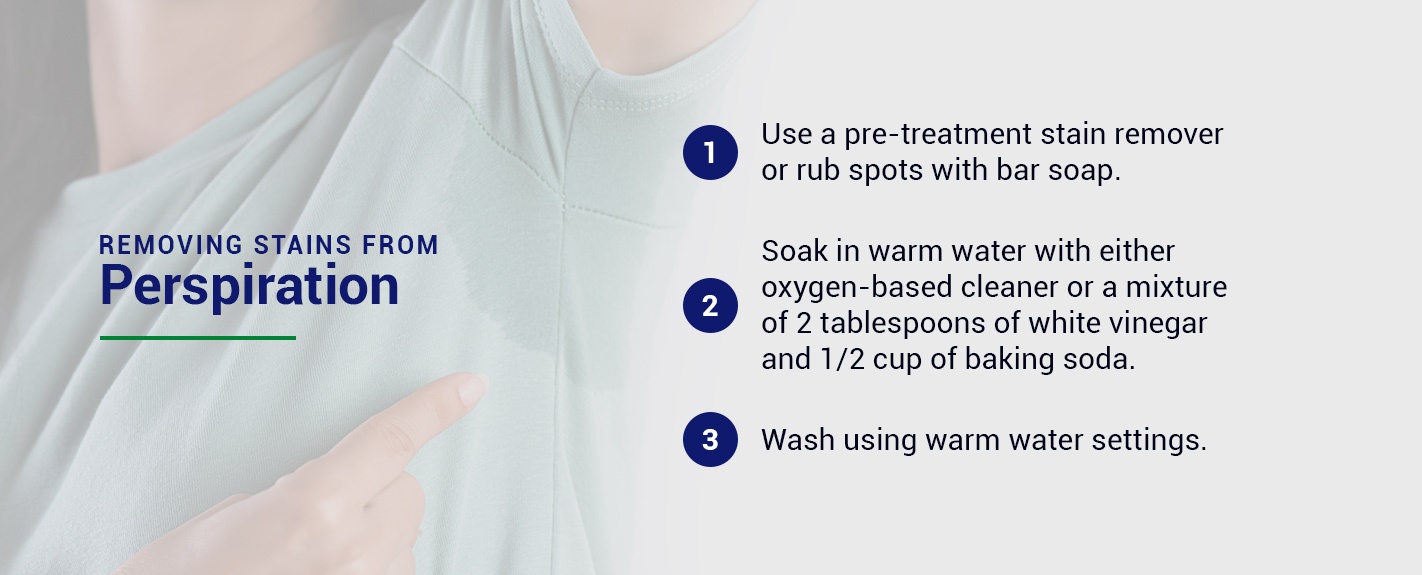Spills and stains are an inevitable part of daily life. Whether they’re from a coffee or wine spill, mud or grass, a spot of paint, markers or more, these annoying stains can be difficult to get out. When you notice a stain, don’t panic. The solution may not be as complicated as you think.
Check out our guidelines for non-toxic stain removal tips and methods to remove stains from clothing with home remedies.
General Stain Removal Guidelines
Whatever type of stain you’re dealing with, there are some general tips to keep in mind:
- Act fast: The faster you deal with a stain, the better your chances of success. Sometimes you may not be at home or near a laundry facility when you notice a stain. Try to deal with the stain as soon as possible, rather than throwing the item in the hamper to deal with later. Blot away any excess liquids quickly, and scrape away solids like wax with a knife.
- Apply stain remover for clothes to the underside of the fabric: Though you might think you should put your stain remover product directly on the stain, it’s actually more effective when you apply it to the back of the garment. This helps push the stain away from the fabric, rather than deeper into the fibers. Place the stained side down on a paper towel or rag while you treat the fabric from the back.
- Take extra care with delicates: Avoid rubbing and using harsh stain treatments on delicate fabrics. If an item is labeled for dry clean only, bring it in as soon as possible and let the professionals handle it.
- Don’t use the dryer until the stain is gone: Sometimes after treating a stain, it still doesn’t come out completely. If this is the case, try removing the stain again and completing another wash cycle. The dryer will set stains in, so check the item before drying. Have patience, try your best, and understand that sometimes a stain just won’t come out.
- Keep common stain-fighters on hand: Beyond laundry detergent and stain remover products, make sure you have some of these other basics to help fight stains — white vinegar, bleach, dish soap, oxygen-based cleaner, and hydrogen peroxide.
Common Stains and How to Remove Them
Now that you have some general tips for removing stains from clothing, let’s take a look at some specific home remedies and stain removal hacks for some of the most common stains. Keep this clothing stain removal guide handy for the next time you have an untimely spill or clothing disaster.
Here are some of the most common stains and stain removal techniques for each:
 Adhesives
Adhesives
- Harden the residue on the stain by freezing the garment or applying ice.
- Use a dull knife to scrape away any solids.
- Apply a stain removal product or cleaning product specifically designed for removing stickers, glues and other adhesives.
- Rinse off any remaining residue and launder as usual.
Baby Food and Baby Formula
- Scrape off any solid food with a dull knife.
- Use a pre-treating product with enzymes for formula stains, or an oxygen-based cleaner on baby food.
- Soak for at least 30 minutes or longer before laundering.
Blood
- Blot away any excess blood, and soak immediately in cold water for at least 30 minutes.
- Treat blood stains using an oxygen-based cleaner, enzyme cleaner or hydrogen peroxide.
- Launder, using bleach for white fabrics.
- Repeat the process if stains remain.
Butter
- Pre-treat with a stain remover product for clothes.
- Wash normally, using the hottest water recommended for that type of fabric to help remove butter and similar oils.
Candle Wax
- Scrape off as much wax as possible using a dull knife.
- Sandwich the stained area in layers of paper towels and iron over the area, using a warm setting to melt away the wax.
- Replace the paper towels often to prevent melted wax from bleeding through to the iron or other places on the fabric.
- With clean paper towels under the stain, blot with a stain remover or pre-treatment of choice and let dry.
- Wash as normal. If any stain remains after washing, use color-safe bleach or oxygen-based cleaner and wash again.
Chocolate
- Allow any melted chocolate to dry and harden. You can place the garment in the freezer to speed up the process if necessary.
- Gently scrape off as much of the hardened chocolate as possible.
- Soak in cool water.
- Use a drop of laundry detergent or a stain remover on the spot.
- Launder using a hot water setting.
Coffee and Tea
- Blot as much of the liquid as possible, and then soak in cool water.
- Apply a pre-treatment or stain remover product to the stain. Alternatively, try a soak with a small squirt of dish soap and vinegar in lukewarm water.
- If safe for your fabric, wash using bleach or an oxygen-based bleach.
Cosmetics
- Place stain face-down on a clean paper towel.
- Gently rub the back of the stained area using a stain remover for clothes or laundry detergent for lipstick and mascara, or rubbing alcohol for makeup.
- Rinse and soak for 30 minutes.
- Rinse again and launder normally, using bleach for white fabrics.
Crayon
- Follow directions for candle wax, especially for melted crayons.
or
- Dampen any affected areas and rub bar soap over the stain.
- Wash using hot water and one cup of baking soda.
Dairy Products
Dairy products like milk, yogurt, ice cream, and others can create sneaky stains that turn yellow later.
- Pre-treat milky stains by rubbing detergent or enzyme cleaner into the spot.
- Work the product into the fibers of the cloth with your fingers or a soft brush.
- Soak in cold water for at least 30 minutes, or longer for dried and set stains.
- Wash. If a stain remains, repeat the process before drying.
Deodorants
- Apply liquid laundry detergent or a stain-removing product directly on the stain. For heavier stains, let this sit for a few minutes.
- Wash as usual.
Alternatives to try:
- Soak the garment in white vinegar and gently brush the stain with a toothbrush. Wash in hot water.
- Rub dry deodorant stains with a clean sock or nylon stocking to remove the residues before washing.
- Make a paste with water and baking soda, or crushed aspirin for whites, and rub the paste into the stain before washing.
Dinginess or Discolorations
- Soak colored items for 30 minutes in a mixture of warm water, two squirts of dish soap and 2 tablespoons of ammonia. Use warm water and bleach for whites.
- Drain and rinse.
- Soak again in warm water with 1/4 cup of vinegar.
- Rinse again and then launder in hot water with oxygen-based cleaner and your regular detergent.
Grass
- Soak fabric in cold water with an oxygen-based cleaning agent or an enzyme cleaner.
- Wash as usual, using bleach for whites. If the stain persists, repeat the soak-and-wash process.
Grease, Gas, and Oil
- Drip cold water and dish soap onto the stain. Dish soaps have great grease-cutting abilities.
- Gently rub the stain with a toothbrush to work in the soap.
- Rinse and wash with hot water.
Note: Clothing with gasoline, oils, and grease can be a fire hazard in the dryer. Wash these items alone, and check for remaining stains or gas smells before drying. Wash again if needed.
Gum
- Remove as much gum as you can from the spot.
- Apply ice or place the whole garment in the freezer for 30 minutes to harden the gum.
- Scrape with a knife and rub with a toothbrush to remove all traces of the gum.
- Wash normally after all gum is removed.
Mildew
- Make a paste of lemon juice and salt and rub the paste into mildew spots.
- Wash using hot water and a cup of vinegar or bleach in the wash cycle. For white items, use bleach.
- Dry in the sunlight if possible. Repeat the process if mildew remains.
Note: Severe mildew damage may be beyond repair.
Mud
- Let clothing dry and brush off any dried mud outside.
- Soak or pre-treat fabric with laundry detergent or an enzyme cleaner.
- Wash as usual.
Mustard
- Rinse the garment under cold water to loosen the mustard stain.
- Wash using a hot water setting and bleach — preferably chlorine bleach if recommended for your fabric.
Nail Polish
- If the nail polish stain is not already dry, scrape or blot away as much as possible.
- Place the stain face-down on clean paper towels.
- Blot from behind with nail polish remover.
- Replace the paper towels often to draw out more of the paint and prevent it from spreading.
- Repeat until the stain disappears.
- Rinse well and launder as usual.
Note: Nail polish stains are notoriously difficult and may not come out completely. Do not use nail polish remover on wool, acetate or any other delicate fabrics as it can damage the fabric.
Paint
For water-based paints, act quickly as dried paint generally does not come out.
- Rinse with warm water to remove as much wet paint as possible.
- Wash normally.
For oil-based paints:
- Use the recommended paint thinner or solvent for your particular type of paint to dab at the stain. Use turpentine if no products are recommended or available.
- Rinse completely and treat spots with laundry detergent, stain remover for clothes or a bar of soap.
- Rinse again and wash as usual.
Perfume
- Blot away any excess spilled perfume.
- Combine 1/2 teaspoon dish detergent, 1 teaspoon white vinegar and 1 cup of water and dab the mixture on the stain.
- Blot again with a clean cloth and wash as usual.
Permanent Marker
- Put the stained area face-down on clean paper towels and gently rub detergent or stain remover into the back of the stain.
- Rinse and soak in warm water mixed with color-safe powdered bleach.
- Rinse again and wash normally.
Alternatives to try:
- Spray the stain with hair spray and let it sit for a few minutes.
- Apply rubbing alcohol to the back of the stain and dab with paper towels.
- Soak the stained area in a bowl of milk to help draw out the color. Change the milk if needed until it’s clean.
Perspiration
If you experience the familiar feeling of underarm sweat, you know sweat can mark your white shirts with an unpleasant color and odor. Learning how to get armpit stains out of shirts can save you money instead of buying new clothing every time you have a sweaty day.
What Causes Yellow Armpit Stains on White Shirts?
Fighting off pit stains may be all too common in your wardrobe, so what is it that creates this problem? Believe it or not, your sweat alone does not make a stain. Sweat moisture reacts with your skin’s natural bacteria and deodorant, causing a yellowish color on white shirts.
Antiperspirant’s main ingredient is aluminum, which can reduce sweating and mark white clothing. Stains may appear after a few rounds through your washing cycle. Once you know how to get sweat stains out of your shirts, you won’t have to worry about wearing your favorite antiperspirant.
How to Get Yellow Armpit Stains Out of White Shirts
Sweating is a fact of life, so we have tips on how to remove underarm stains. A sweat stain is essentially residue buildup, and with the right tools, you can make it look like it was never there. Here’s our guide on how to get yellow stains out of white shirts:
- Use a pre-treatment stain remover or rub spots with bar soap.
- Soak in warm water for 30 minutes with either oxygen-based cleaner or a mixture of 2 tablespoons of white vinegar and 1/2 cup of baking soda.
- Wash using warm water settings.
- Dry in the sun for even brighter results.
Alternatives to try:
- Combine hydrogen peroxide, baking soda, and salt to brush into the stain. Follow up with a cold cycle wash.
- Soak your shirt overnight in equal parts hydrogen peroxide and water before treating the stain.
- Use dish soap with hydrogen peroxide and baking soda to lift the stain before washing.
How to Prevent Future Armpit Stains From White Shirts and Other Tips
While there are many ways to remove underarm stains, sometimes it’s better to avoid them altogether. Because sweat stains result from a natural reaction, some solutions will work better for you than others. Here are a few ways you can prevent future armpit stains:
- Choose an effective antiperspirant: Antiperspirant blocks armpit glands from releasing sweat. Some people apply a thin layer at night so the ingredients can set in while your armpits are dry and inactive.
- Trim or shave armpit hair: Your armpit hair may be the reason the sweat is sticking to your clothes. Trimming or shaving the hair can get rid of the moisture that it holds.
- Wear an undershirt: A white undershirt is a great buffer between your armpits and your dress shirt. Make sure your undershirt is made of a thin material so it doesn’t increase your sweating.
- Clean clothes immediately: Most people don’t have time to wash their white shirts immediately after sweating. Just rinsing with cold water before putting it through the wash can reduce some of the oils that create yellowish stains.
Check out these other tips on how to get sweat stains out of shirts:
- Don’t bleach: The active ingredients in bleach can react with sweat and deodorant residue and worsen your stain. Opt for a hydrogen peroxide solution instead of bleach.
- Trust the professionals: When it comes to stains of any kind, trust your local dry cleaners to care for the delicate pieces. Dry clean only clothing should always be handled by a professional.
Pine Resin
- Use a dry-cleaning solvent to dab at the stained area and let air dry.
- Soak garment in warm water with 1 cup of liquid detergent and a few drops of ammonia. Do not use bleach.
- Launder as usual, using liquid laundry soap.
Shoe Polish
- Scrape away any solids if using paste-style shoe polish.
- Pre-treat with liquid detergent or stain-removing product, gently rubbing the product into the stain.
- Rinse and launder with fabric-safe bleach.
Tobacco
- Rinse the stained area and rub with bar soap. Rinse again.
- Soak garment using an enzyme cleaner.
- Wash as usual.
Tomato-Based Stains
Including stains from tomato sauce, tomato juice, ketchup, barbecue sauce and more.
- Remove any excess solids, taking care not to rub the sauce in or spread the stain.
- Run cold water through from the back of the fabric, and pre-treat with a stain remover for clothes.
- Soak in lukewarm water with color-safe bleach or vinegar for 30 minutes.
- Wash normally.
Watermelon
These tricky stains often dry invisibly and oxidize later to show yellow or brown spots. To prevent this, always wash clothing with watermelon stains in the hottest water as soon as possible.
Wine and Fruit Juices
- Mix together 2/3 cup of rubbing alcohol and 1 tablespoon of vinegar. Blot this solution onto the stain until it starts to disappear.
- Wash normally.
Or:
- Soak the garment for at least 30 minutes in cool water.
- Treat with a stain-removing product.
- Wash as usual, using bleach if it is safe for the fabric.
Wood Stain
- Place the stained area face-down on a thick layer of paper towels.
- Blot the area with acetone for water-based stains or mineral spirits for oil-based wood stains.
- Continue blotting and moving the stain to clean areas of the paper towel until the stain is gone.
- Rinse well and launder.
Professional Attention for Tough Stains
If you’ve tried everything and your stain won’t come out, or you have a delicate item needing extra care, let the professionals at Classic Drycleaners take over. With eight great locations all over the Harrisburg metro area and a friendly, experienced staff ready to help, you’ll find convenient help near you for life’s little messes.
As Harrisburg’s preferred garment care specialists, we take great pride in our customers and our community. For excellent service and expert stained clothing help, come to Classic Drycleaners. Find the closest location to you and get help with your stains today!
Tags: stain removal



 Adhesives
Adhesives

